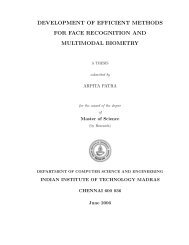The Enigma of Group Theory - Department of Computer Science ...
The Enigma of Group Theory - Department of Computer Science ...
The Enigma of Group Theory - Department of Computer Science ...
You also want an ePaper? Increase the reach of your titles
YUMPU automatically turns print PDFs into web optimized ePapers that Google loves.
http://www.cs.bris.ac.uk University <strong>of</strong> Bristol, <strong>Department</strong> <strong>of</strong> <strong>Computer</strong> <strong>Science</strong><br />
UCWBLR ZSETEY SLVMQH SGIMVW PMRWGV<br />
VNGCTP OQDPNS CBRVPV KSCJEA GSTGEU<br />
DQLSNL HXYYHF GETGSU EEKLSJ OSQPEB<br />
WISIIT TXFEHX ZAMTAM VEMCSM LQPFNI<br />
LOIFMW JXHUHZ PYXWFQ FAYQAF QJPOUI<br />
EPILWW DOGSMP ADSDRT XLJXQK BKEAKY<br />
...... ...... ...... ...... ......<br />
DDESRY QJCOUA JEZUSN MUXROQ SLPMQI<br />
RRONYG ZMOTGG XUOXOG HIUYIE KCPJLI<br />
DSESEY OSPPEI QCPOLI HUXYOQ NYIKFW<br />
If we take the last one <strong>of</strong> these and look at it in more detail. We know that there are three underlying<br />
secret letters, say l1, l2 and l3. We also know that<br />
and<br />
Hence, given that ɛj −1 = ɛj, we have<br />
l1 ɛ0 = N, l2 ɛ1 = Y, l3 ɛ2 = I,<br />
l1 ɛ3 = K, l2 ɛ4 = F, l3 ɛ5 = W.<br />
N ɛ0ɛ3 = l1 ɛ0ɛ0ɛ3 = l1 ɛ3 = K, Y ɛ1ɛ4 = F, I ɛ2ɛ5 = W.<br />
Continueing in this way we can compute a permutation representation <strong>of</strong> the three products as follows:<br />
ɛ0 · ɛ3 = (ADSMRNKJUB)(CV)(ELFQOPWIZT)(HY),<br />
ɛ1 · ɛ4 = (BPWJUOMGV)(CLQNTDRYF)(ES)(HX),<br />
ɛ2 · ɛ5 = (AC)(BDSTUEYFXQ)(GPIWRVHZNO)(JK).<br />
From these we wish to deduce the values <strong>of</strong> ɛ0, ɛ1, . . . , ɛ5. We will use the fact that ɛj is a product <strong>of</strong><br />
disjoint transpositions and Facts 2 and 3.<br />
We take the first product and look at it in more detail. We take the sets <strong>of</strong> two cycles <strong>of</strong> equal degree<br />
and write them above one another, with the bottom one reversed in order, i.e.<br />
A D S M R N K J U B<br />
T Z I W P O Q F L E<br />
C V<br />
Y H<br />
We now run through all possible shifts <strong>of</strong> the bottom rows. Each shift gives us a possible value <strong>of</strong> ɛ0 and<br />
ɛ3. <strong>The</strong> value <strong>of</strong> ɛ0 is obtained from reading <strong>of</strong>f the disjoint transpositions from the columns, the value<br />
<strong>of</strong> ɛ3 is obtained by reading <strong>of</strong>f the transpositions from the “<strong>of</strong>f diagonals”. For example with the above<br />
orientation we would have<br />
ɛ0 = (AT)(DZ)(SI)(MW)(RP)(NO)(KQ)(JF)(UL)(BE)(CY)(VH),<br />
ɛ3 = (DT)(SZ)(MI)(RW)(NP)(KO)(JQ)(UF)(BL)(AE)(VY)(CH).<br />
But we have 20 = 2 · 10 such orientations, so there are 20 possible values for ɛ0 and ɛ3.<br />
Now, to reduce this number we need to really on stupid operators. Various operators had a tendency<br />
to always select the same three letter message key. For example popular choices where QWE (the first<br />
letters on the keyboard). One operator used the letters <strong>of</strong> his girlfriend name, Cillie, hence such “cribs”<br />
(or guessed/known plaintexts in todays jargon) became known as “Cillies”. Note, for our analysis here<br />
we only need one Cillie for the day when we wish to obtain the internal wiring <strong>of</strong> rotor I.<br />
In our dummy example, suppose we guess (correctly) that the first message key is indeed QWE. This<br />
means that UCWBLR is the encryption <strong>of</strong> QWE twice, this in turn tells us how to align our cycle <strong>of</strong> length<br />
10 in the first permutation, as under ɛ0 the letter Q must encrypt to U.<br />
A D S M R N K J U B<br />
L E T Z I W P O Q F<br />
We can check that this is consistent as we see that Q under ɛ3 must then encrypt to B. If we guessed one<br />
more such Cillies we can reduce the number <strong>of</strong> possibilities for ɛ1, . . . , ɛ6. Assuming we carry on in this<br />
10










